Entry Database : PDB / ID : 3e7cTitle Glucocorticoid Receptor LBD bound to GSK866 Glucocorticoid receptor Nuclear receptor coactivator 2 Keywords / / / / / / / / / / / / / / / / / Function / homology Function Domain/homology Component
/ / / / / / / / / / / / / / / / / / / / / / / / / / / / / / / / / / / / / / / / / / / / / / / / / / / / / / / / / / / / / / / / / / / / / / / / / / / / / / / / / / / / / / / / / / / / / / / / / / / / / / / / / / / / / / / / / / / / / / / / / / / / / / / / / / / / / / / / / / / / / / / / / / / / / / / / / / / / / / / Biological species Homo sapiens (human)Method / / / / Resolution : 2.15 Å Authors Madauss, K.P. / Williams, S.P. / Mclay, I. / Stewart, E.L. / Bledsoe, R.K. Journal : Bioorg.Med.Chem.Lett. / Year : 2008Title : The first X-ray crystal structure of the glucocorticoid receptor bound to a non-steroidal agonist.Authors : Madauss, K.P. / Bledsoe, R.K. / Mclay, I. / Stewart, E.L. / Uings, I.J. / Weingarten, G. / Williams, S.P. History Deposition Aug 18, 2008 Deposition site / Processing site Revision 1.0 Nov 25, 2008 Provider / Type Revision 1.1 Jul 13, 2011 Group / Version format complianceRevision 1.2 Apr 2, 2014 Group Revision 1.3 Oct 25, 2017 Group / Category Revision 1.4 Oct 20, 2021 Group / Derived calculations / Category / struct_ref_seq_dif / struct_siteItem _database_2.pdbx_DOI / _database_2.pdbx_database_accession ... _database_2.pdbx_DOI / _database_2.pdbx_database_accession / _struct_ref_seq_dif.details / _struct_site.pdbx_auth_asym_id / _struct_site.pdbx_auth_comp_id / _struct_site.pdbx_auth_seq_id Revision 1.5 Feb 21, 2024 Group / Category / chem_comp_bondRevision 1.6 Apr 3, 2024 Group / Category
Show all Show less
 Open data
Open data Basic information
Basic information Components
Components Keywords
Keywords TRANSCRIPTION / GR /
TRANSCRIPTION / GR /  Glucocorticoid Receptor /
Glucocorticoid Receptor /  Nuclear Receptor / Alternative initiation / Chromatin regulator / Disease mutation / DNA-binding / Lipid-binding / Metal-binding /
Nuclear Receptor / Alternative initiation / Chromatin regulator / Disease mutation / DNA-binding / Lipid-binding / Metal-binding /  Nucleus /
Nucleus /  Phosphoprotein /
Phosphoprotein /  Pseudohermaphroditism / Receptor / Steroid-binding /
Pseudohermaphroditism / Receptor / Steroid-binding /  Transcription regulation /
Transcription regulation /  Zinc-finger / Activator
Zinc-finger / Activator Function and homology information
Function and homology information steroid hormone binding / PTK6 Expression / neuroinflammatory response / glucocorticoid metabolic process / microglia differentiation / mammary gland duct morphogenesis /
steroid hormone binding / PTK6 Expression / neuroinflammatory response / glucocorticoid metabolic process / microglia differentiation / mammary gland duct morphogenesis /  maternal behavior ...Regulation of NPAS4 gene transcription / regulation of glucocorticoid biosynthetic process / nuclear glucocorticoid receptor activity /
maternal behavior ...Regulation of NPAS4 gene transcription / regulation of glucocorticoid biosynthetic process / nuclear glucocorticoid receptor activity /  steroid hormone binding / PTK6 Expression / neuroinflammatory response / glucocorticoid metabolic process / microglia differentiation / mammary gland duct morphogenesis /
steroid hormone binding / PTK6 Expression / neuroinflammatory response / glucocorticoid metabolic process / microglia differentiation / mammary gland duct morphogenesis /  maternal behavior / astrocyte differentiation / cellular response to glucocorticoid stimulus /
maternal behavior / astrocyte differentiation / cellular response to glucocorticoid stimulus /  motor behavior /
motor behavior /  regulation of gluconeogenesis / adrenal gland development / RNA polymerase II intronic transcription regulatory region sequence-specific DNA binding / cellular response to steroid hormone stimulus / locomotor rhythm /
regulation of gluconeogenesis / adrenal gland development / RNA polymerase II intronic transcription regulatory region sequence-specific DNA binding / cellular response to steroid hormone stimulus / locomotor rhythm /  aryl hydrocarbon receptor binding / regulation of lipid metabolic process / cellular response to Thyroglobulin triiodothyronine / regulation of glucose metabolic process / Synthesis of bile acids and bile salts / Endogenous sterols /
aryl hydrocarbon receptor binding / regulation of lipid metabolic process / cellular response to Thyroglobulin triiodothyronine / regulation of glucose metabolic process / Synthesis of bile acids and bile salts / Endogenous sterols /  estrogen response element binding / Synthesis of bile acids and bile salts via 27-hydroxycholesterol / FOXO-mediated transcription of oxidative stress, metabolic and neuronal genes / Synthesis of bile acids and bile salts via 7alpha-hydroxycholesterol / intracellular steroid hormone receptor signaling pathway / core promoter sequence-specific DNA binding / regulation of cellular response to insulin stimulus / Recycling of bile acids and salts / cellular response to hormone stimulus / cellular response to transforming growth factor beta stimulus / positive regulation of adipose tissue development / HSP90 chaperone cycle for steroid hormone receptors (SHR) in the presence of ligand / peroxisome proliferator activated receptor signaling pathway / RORA activates gene expression / TBP-class protein binding / Regulation of lipid metabolism by PPARalpha /
estrogen response element binding / Synthesis of bile acids and bile salts via 27-hydroxycholesterol / FOXO-mediated transcription of oxidative stress, metabolic and neuronal genes / Synthesis of bile acids and bile salts via 7alpha-hydroxycholesterol / intracellular steroid hormone receptor signaling pathway / core promoter sequence-specific DNA binding / regulation of cellular response to insulin stimulus / Recycling of bile acids and salts / cellular response to hormone stimulus / cellular response to transforming growth factor beta stimulus / positive regulation of adipose tissue development / HSP90 chaperone cycle for steroid hormone receptors (SHR) in the presence of ligand / peroxisome proliferator activated receptor signaling pathway / RORA activates gene expression / TBP-class protein binding / Regulation of lipid metabolism by PPARalpha /  steroid binding / cellular response to dexamethasone stimulus / BMAL1:CLOCK,NPAS2 activates circadian gene expression / SUMOylation of transcription cofactors / Activation of gene expression by SREBF (SREBP) / nuclear receptor coactivator activity /
steroid binding / cellular response to dexamethasone stimulus / BMAL1:CLOCK,NPAS2 activates circadian gene expression / SUMOylation of transcription cofactors / Activation of gene expression by SREBF (SREBP) / nuclear receptor coactivator activity /  synaptic transmission, glutamatergic / response to progesterone /
synaptic transmission, glutamatergic / response to progesterone /  chromosome segregation /
chromosome segregation /  nuclear receptor binding / RNA polymerase II transcription regulatory region sequence-specific DNA binding /
nuclear receptor binding / RNA polymerase II transcription regulatory region sequence-specific DNA binding /  Hsp90 protein binding / circadian regulation of gene expression / Heme signaling / SUMOylation of intracellular receptors / mRNA transcription by RNA polymerase II / Activated PKN1 stimulates transcription of AR (androgen receptor) regulated genes KLK2 and KLK3 / Transcriptional activation of mitochondrial biogenesis / PPARA activates gene expression / Cytoprotection by HMOX1 / DNA-binding transcription repressor activity, RNA polymerase II-specific / positive regulation of miRNA transcription / Transcriptional regulation of white adipocyte differentiation / Nuclear Receptor transcription pathway / spindle / RNA polymerase II transcription regulator complex / Regulation of RUNX2 expression and activity /
Hsp90 protein binding / circadian regulation of gene expression / Heme signaling / SUMOylation of intracellular receptors / mRNA transcription by RNA polymerase II / Activated PKN1 stimulates transcription of AR (androgen receptor) regulated genes KLK2 and KLK3 / Transcriptional activation of mitochondrial biogenesis / PPARA activates gene expression / Cytoprotection by HMOX1 / DNA-binding transcription repressor activity, RNA polymerase II-specific / positive regulation of miRNA transcription / Transcriptional regulation of white adipocyte differentiation / Nuclear Receptor transcription pathway / spindle / RNA polymerase II transcription regulator complex / Regulation of RUNX2 expression and activity /  nuclear receptor activity / positive regulation of neuron apoptotic process / sequence-specific double-stranded DNA binding /
nuclear receptor activity / positive regulation of neuron apoptotic process / sequence-specific double-stranded DNA binding /  Circadian Clock / chromatin organization / HATs acetylate histones /
Circadian Clock / chromatin organization / HATs acetylate histones /  gene expression / DNA-binding transcription activator activity, RNA polymerase II-specific / Estrogen-dependent gene expression /
gene expression / DNA-binding transcription activator activity, RNA polymerase II-specific / Estrogen-dependent gene expression /  transcription regulator complex / Potential therapeutics for SARS /
transcription regulator complex / Potential therapeutics for SARS /  transcription coactivator activity /
transcription coactivator activity /  nuclear body /
nuclear body /  protein dimerization activity / DNA-binding transcription factor activity, RNA polymerase II-specific /
protein dimerization activity / DNA-binding transcription factor activity, RNA polymerase II-specific /  mitochondrial matrix / nuclear speck / RNA polymerase II cis-regulatory region sequence-specific DNA binding / DNA-binding transcription factor activity / protein domain specific binding /
mitochondrial matrix / nuclear speck / RNA polymerase II cis-regulatory region sequence-specific DNA binding / DNA-binding transcription factor activity / protein domain specific binding /  cell division / negative regulation of DNA-templated transcription /
cell division / negative regulation of DNA-templated transcription /  centrosome / apoptotic process /
centrosome / apoptotic process /  synapse /
synapse /  chromatin binding /
chromatin binding /  chromatin / regulation of DNA-templated transcription / regulation of transcription by RNA polymerase II /
chromatin / regulation of DNA-templated transcription / regulation of transcription by RNA polymerase II /  protein kinase binding / negative regulation of transcription by RNA polymerase II /
protein kinase binding / negative regulation of transcription by RNA polymerase II /  signal transduction / positive regulation of transcription by RNA polymerase II
signal transduction / positive regulation of transcription by RNA polymerase II
 Homo sapiens (human)
Homo sapiens (human) X-RAY DIFFRACTION /
X-RAY DIFFRACTION /  SYNCHROTRON /
SYNCHROTRON /  MOLECULAR REPLACEMENT /
MOLECULAR REPLACEMENT /  molecular replacement / Resolution: 2.15 Å
molecular replacement / Resolution: 2.15 Å  Authors
Authors Citation
Citation Journal: Bioorg.Med.Chem.Lett. / Year: 2008
Journal: Bioorg.Med.Chem.Lett. / Year: 2008 Structure visualization
Structure visualization Molmil
Molmil Jmol/JSmol
Jmol/JSmol Downloads & links
Downloads & links Download
Download 3e7c.cif.gz
3e7c.cif.gz PDBx/mmCIF format
PDBx/mmCIF format pdb3e7c.ent.gz
pdb3e7c.ent.gz PDB format
PDB format 3e7c.json.gz
3e7c.json.gz PDBx/mmJSON format
PDBx/mmJSON format Other downloads
Other downloads https://data.pdbj.org/pub/pdb/validation_reports/e7/3e7c
https://data.pdbj.org/pub/pdb/validation_reports/e7/3e7c ftp://data.pdbj.org/pub/pdb/validation_reports/e7/3e7c
ftp://data.pdbj.org/pub/pdb/validation_reports/e7/3e7c Links
Links Assembly
Assembly
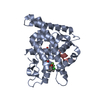

 Components
Components / GR / Nuclear receptor subfamily 3 group C member 1
/ GR / Nuclear receptor subfamily 3 group C member 1
 Homo sapiens (human) / Gene: NR3C1, GRL / Production host:
Homo sapiens (human) / Gene: NR3C1, GRL / Production host: 
 Escherichia coli (E. coli) / References: UniProt: P04150
Escherichia coli (E. coli) / References: UniProt: P04150 / NCoA-2 / Transcriptional intermediary factor 2
/ NCoA-2 / Transcriptional intermediary factor 2
 Homo sapiens (human) / References: UniProt: Q15596
Homo sapiens (human) / References: UniProt: Q15596 Glycerol
Glycerol Water
Water X-RAY DIFFRACTION / Number of used crystals: 1
X-RAY DIFFRACTION / Number of used crystals: 1  Sample preparation
Sample preparation
 SYNCHROTRON / Site:
SYNCHROTRON / Site:  APS
APS  / Beamline: 17-ID / Wavelength: 0.97 Å
/ Beamline: 17-ID / Wavelength: 0.97 Å : 0.97 Å / Relative weight: 1
: 0.97 Å / Relative weight: 1 
 molecular replacement
molecular replacement Processing
Processing :
:  MOLECULAR REPLACEMENT
MOLECULAR REPLACEMENT Movie
Movie Controller
Controller






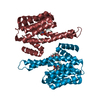
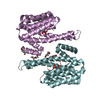


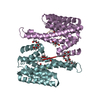
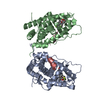


 PDBj
PDBj





















